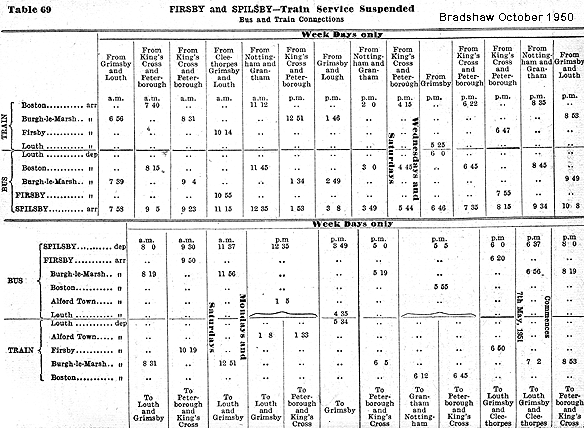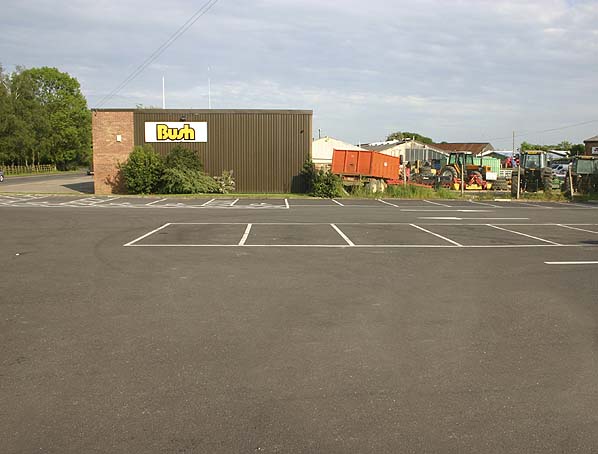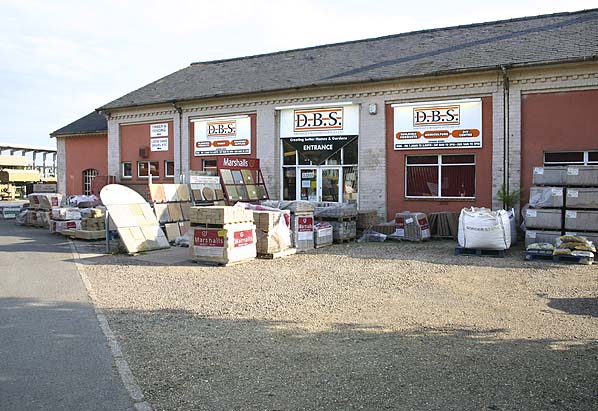Notes: The station had a single platform on the up side of the line with a run round loop. The main station building incorporated the station master's house, booking office and waiting room with a short canopy. The goods yard was sited on both side of the line, there were two sidings on the up side running behind the platform, one of them passing through a large brick goods shed. On the down side of the line there were four sidings, one serving a cattle dock with cattle pens alongside, another ran into the single road engine shed. The most southerly was a private siding serving Robinsons works. There was also a 5 ton crane opposite the station building and weighbridge and office on the down side. The station didn't have a signal box, just two ground frames.
The one locomotive used on the line was supplied by Boston shed and shedded at Spilsby during the week. A well directly beneath the shed supplied water to the shed and station. The 8500 tank visible on the shed roof was refilled by using the branch engine's steam heating pipe, connected to an external injector mounted on the building. Two hours at 40psi were needed to raise the level in the tank through one foot. There was also a hand pump for drinking water. The shed closed in 1931 but stood until total closure of the line in 1958 because of the unusual water arrangement. It was demolished by 1962.
The remaining station buildings were demolished in 1965 and the Vale Road industrial estate now occupied the site.
BRIEF HISTORY OF THE SPILSBY & FIRSBY RAILWAY
The first proposal for a branch line from the GNR at Firsby to Spilsby was made in October 1864. It was felt that Spilsby had suffered by not having a railway, compared to other local market towns like Burgh-le-Marsh; Spilsby had lost much of its trade since the opening of the East Lincolnshire Railway in 1848.
The proposal was enthusiastically received; a land survey was made in December 1864 and an agreement was made with the GNR to operate the line and provide rolling stock and staff for 21 years in return for 60 of gross receipts.
| The line was authorised by Parliament on 5th July, 1865 with an authorised capital of £20,000 and loans of £8,333 but after early enthusiasm, the Spilsby & Firsby Railway found it difficult to raise sufficient capital and construction was delayed, not starting until March 1867. Once work was underway however it proceeded rapidly from the Spilsby end, with track |
 |
reaching Firsby in August 1867.
The line was inspected by the Board of Trade in early in 1868 and after a few changes suggested by the GNR the 4 mile 14 chain single track branch line opened on 1st May 1868 with one intermediate station at Halton Holgate. At Firsby, a new signal box was built and trains ran into and out of the down platform. There were five daily trains with an additional train from Boston Market on Mondays and to Boston Market on Wednesdays. Locomotives for the branch were provided by Boston shed and were shedded overnight at Spilsby.
Despite the branch being well used, the company didn't declare a profit until 1878. Profits continued to rise until 1885 and then dropped dramatically and it was soon clear the company was in serious financial difficulty. On 25th July 1890 an Act authorised the GNR to purchase the line for £20,000.
Under GNR control there were several proposals to extend the line to join up with the Horncastle branch to create a direct route between Skegness with Lincoln and on to Doncaster and Sheffield. A bill was put before Parliament in 1884 but came to nothing as did a similar scheme in 1886.
During its peak, the railway ran 7 trains a day with some being mixed passenger and goods trains; a goods and coal train was run through as required. Other than incoming coal supplies and general goods, traffic consisted of all types of farm produce and supplies, cattle from Spilsby Market and sheep from the Partney Sheep Fairs. Both petrol and paraffin were also brought in by rail to be distributed from a fuel depot adjacent to the station.
 |
The branch closed to passenger as a war time economy measure on 10th September 1939 and the service was never reinstated but it remained open for goods traffic. In 1958 rumours of total closure of the branch were confirmed by the British Transport Commission who stated that the line would close due to the high cost of replacing a bridge over the Steeping River that was in danger of collapsing. Temporary repairs to the bridge had already been made which caused flooding of the surrounding land. The only solution was to replace the bridge which could not be justified due to the high cost and ever diminishing income from goods traffic on the line.
By 1957 petrol traffic moved over to road transport, general goods traffic was in decline, an upsurge the previous year had simply been as a result of incoming cement products for the airfield expansion at East Kirkby. In that year only 8,109 tons of freight was dealt with at Spilsby and Halton Holgate stations.
 |
Despite some local concern, Spilsby Rural District Council decided not to oppose the closure of the branch but the Parish Council put up a fight claiming that closure of the railway would scupper the town’s plans for expansion with the introduction of light industry. They suggested re-opening the passenger service with cheaper diesel railcars but the cost of |
replacing the bridge outweighed all the benefits of maintaining and upgrading the line and closure was announced for 1st December 1958 with the last train running on Saturday 30th November. Much of the line has now been returned to agriculture
Although closed to passengers in 1939 the service was only treated as 'suspended' and is still shown in Bradshaw at least up to 1950 as 'Train Service Suspended' with a bus timetable.
Tickets from Michael Stewart, route map drawn by Alan Young
Source: The Spilsby to Firsby Railway by AJ Ludlam. Published 1985 by Oakwood Press ISBN 85361 310 9 (Now very expensive from £40 at Amazon!)
Other web sites:Lincolnshire & East Yorkshire Transport Review includes pictures of the line. Dave's Railpics of Lincolnshire. David Enefer's excellent web site crammed with pictures of Lincolnshire stations. Lincolnshire Railway's from the past Adam Cartwright's excellent web site crammed with pictures of Lincolnshire stations.
To see other stations on the Spilsby & Firsby Railway click on the station name:
Firsby & Halton Holgate |

old9.jpg)


old10.jpg)
old7.jpg)
old1.jpg)
old2.jpg)






old_thumb5.jpg)
old_thumb11.jpg)
old_thumb3.jpg)
old_thumb4.jpg)
old_thumb8.jpg)
old_thumb6.jpg)


 Home Page
Home Page